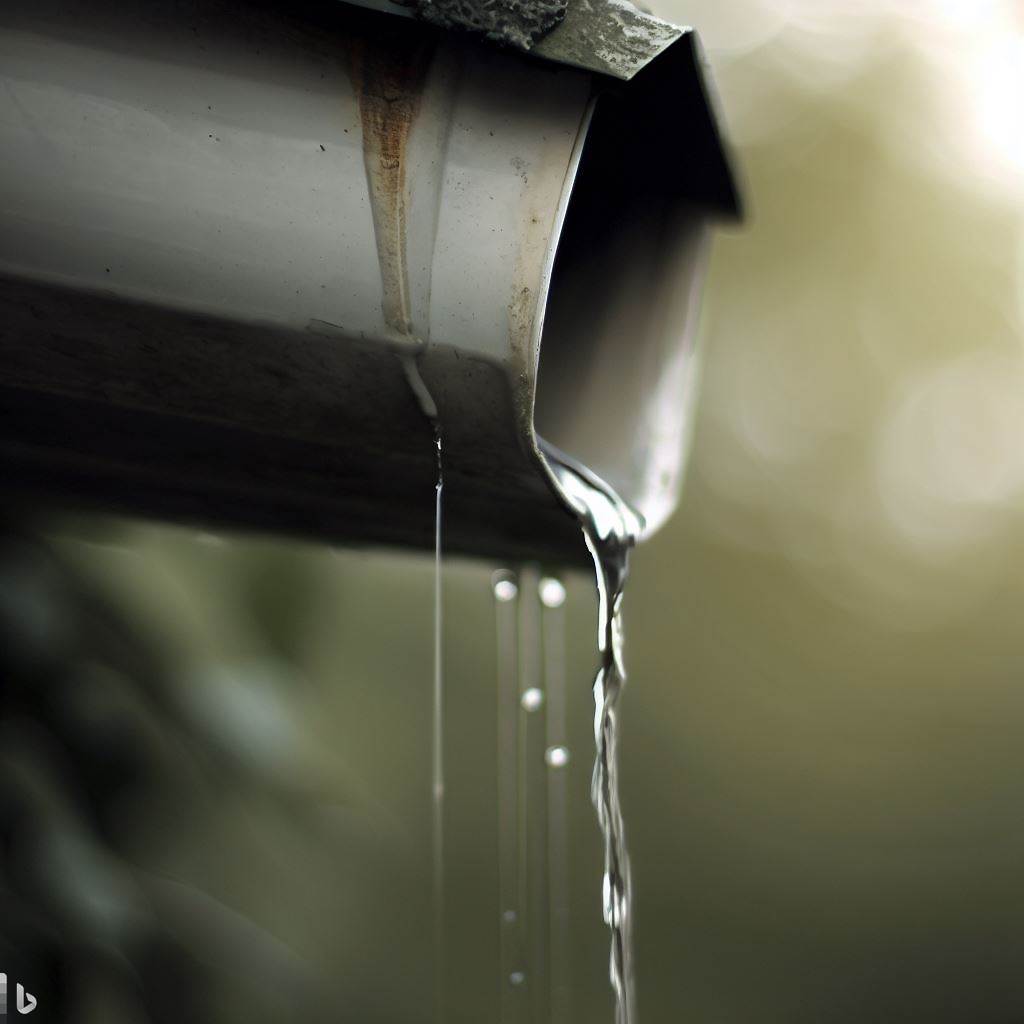We’ve all been there, listening to the rhythmic drip-drop of a downspout on a rainy night. It could be soothing for some, but an annoyance to others. So what can be done about this persistent dripping noise? That’s exactly what we’re going to delve into in this article.
Don’t worry! You won’t have your peaceful nights hijacked by relentless plinking anymore. If you stick with us through this guide, you’ll gain invaluable knowledge that will keep your home quiet and serene even during the heaviest rainstorm.

Together let’s navigate the world of downspouts; because who knew such mundane objects could hold so many secrets? So brace yourself for a journey filled with humor, wit, practical solutions – and maybe even a little bit of suspense (Spoiler Alert: The dripping is not due to tiny rain goblins having a party).
Main Causes of Downspout Dripping Noise
The rhythmic and persistent sound of water dripping from your downspout can quickly become an irritant, disrupting your peace and quiet, especially during rainy seasons. Let’s explore some of the primary factors that contribute to downspout dripping noise and explore how you can tackle each issue.
Inadequate Slope or Alignment
One of the most common culprits behind downspout dripping noise is an inadequate slope or misalignment of the gutter system. If your downspout isn’t properly aligned or doesn’t have a sufficient slope, rainwater may accumulate and pool in the gutter rather than flowing smoothly through the downspout.
As a result, water droplets can linger, creating that incessant dripping sound. To remedy this, ensure that your gutters are installed with the appropriate slope and alignment, allowing rainwater to flow freely.
Clogs and Debris
Over time, leaves, twigs, dirt, and other debris can accumulate in your gutters and downspouts. These obstructions can disrupt the natural flow of water, leading to clogs and causing water to spill over the edges of the gutter system.
When excess water lands on hard surfaces or the ground, it creates the familiar dripping noise. Regular gutter maintenance, including cleaning out debris, is essential to preventing this issue and maintaining proper water flow.
Gutter Size and Design
The size and design of your gutter system play a significant role in downspout dripping noise. If your gutters are undersized for your roof’s surface area or if the design doesn’t account for efficient water drainage, water can overflow and create noise as it drips down.
Upgrading to larger gutters or altering the design to optimize water flow can help mitigate this problem.
Methods for Identifying Source of Downspout Drip Sound
Dealing with the incessant sound of a downspout drip can be a frustrating experience. Identifying the source of the drip sound is the first step toward finding an effective solution. Here are some methods to help you pinpoint the origin of the downspout drip sound:
a. Visual Inspection
Conduct a thorough visual inspection of your gutter system and downspouts during and after rain. Look for any areas where water may be overflowing, pooling, or dripping excessively. Pay attention to the path of water as it flows from the roof to the ground. This can help you identify potential problem areas that contribute to the drip sound.
b. Listen Carefully
During a rain shower, take the time to listen carefully to the sound of the dripping water. Move around your property and follow the sound to its source. This active listening can help you trace the path of the water and identify specific downspouts or sections of the gutter system that are causing the noise.
c. Rain Simulation
If rain is not currently falling, you can simulate rain by using a hose to spray water onto your roof. This will allow you to observe how water flows through your gutter system and identify any areas where drips occur. Enlist the help of a friend or family member to turn the hose on and off while you listen for the drip sound.
d. Dye Test
Introduce a harmless and easily identifiable dye into your gutter system. This can be done by placing a few drops of food coloring into the gutter or downspout. Observe the flow of water and check for the presence of the dye at various points along the gutter system. This can help you track the path of the water and locate the source of the drip sound.
Now that we know these fundamental tips let’s explore five practical tips to help you enjoy a tranquil and dry environment during rainy days.
Practical Tips to Silence Your Downspout Dripping Noise
1. Install a Diverter
One of the simplest and most effective ways to silence downspout dripping noise is by installing a diverter. A diverter is a small device that helps redirect the flow of water away from your downspout, preventing the constant dripping sound.
It’s relatively easy to install and can be found at most home improvement stores. By guiding the water away from a hard surface, like a concrete patio or driveway, you can significantly reduce the noise caused by droplets hitting the ground.
2. Attach an Extension
Another strategy to minimize downspout dripping noise is by attaching an extension to the end of your downspout. Extensions are available in various lengths and designs, allowing you to direct the water flow further away from your home’s foundation.
By extending the distance between the downspout and the ground, you can reduce the impact noise as water lands farther away from surfaces that amplify the sound.
3. Use Sound-Absorbing Materials
If you’re looking for a more comprehensive solution, consider using sound-absorbing materials to dampen downspout dripping noise. Apply adhesive-backed foam tape or weatherstripping along the interior of your downspout or on the surface it lands on.
These materials will help absorb the impact of water droplets, reducing the noise they create. Keep in mind that this method might require a bit more effort and maintenance, as weather conditions can wear down the materials over time.
4. Opt for Rain Chains
Rain chains are not only visually appealing but can also help eliminate downspout dripping noise. These decorative alternatives to traditional downspouts guide rainwater along a series of cups or links, creating a pleasant tinkling sound rather than a repetitive drip. Rain chains can be a charming addition to your home’s exterior and effectively reduce the noise associated with dripping water.
5. Regular Maintenance
Prevention is often the best cure. Regular maintenance of your gutters and downspouts can go a long way in preventing dripping noise from becoming a nuisance. Clean your gutters of debris like leaves, twigs, and dirt to ensure smooth water flow.
Clogs can lead to overflowing gutters and excessive dripping noise. Additionally, check for any leaks or loose components in your gutter system that could contribute to the problem.
How Seasonal Changes Can Affect Downspout Noise Levels
The impact of downspout dripping noise isn’t static; it can vary throughout the year due to seasonal changes. Understanding how different seasons influence this noise can help you anticipate and manage the issue more effectively. Here’s a brief overview of how seasonal changes can affect downspout dripping noise:
- Spring: Spring often brings increased rainfall as well as the melting of snow and ice. This can lead to a higher volume of water flowing through your gutters and downspouts. The combination of rainwater and melting snow can result in more frequent and intense dripping sounds as water is channeled from your roof to the ground.
- Summer: In many regions, summer can bring both sporadic rain showers and dry periods. During rainy spells, downspout dripping noise may persist as water makes its way through the gutter system. However, during drier periods, the noise might decrease significantly, offering some respite.
- Fall: The falling leaves of autumn can pose a unique challenge to your gutter system. Leaves and other debris can accumulate and clog gutters and downspouts, leading to water overflow and increased dripping noise. Regular gutter cleaning becomes particularly important during this season to maintain proper water flow and reduce noise.
- Winter: Winter can bring a different type of challenge – freezing temperatures. Water that accumulates in clogged gutters or downspouts can freeze, leading to blockages and potential damage. While the noise of dripping water may decrease during cold spells, the overall health of your gutter system becomes critical to prevent ice-related issues

Tools And Supplies Necessary for Fixing a Leaky Downspout
A comprehensive list includes:
- wrenches
- sealant
- repair tape
- downspout extensions, etc.
Conclusion
Don’t let downspout dripping noise rain on your parade. With these five practical tips, you can enjoy a quieter and more serene environment during rainy days.
Whether you choose to install a diverter, extend your downspout, use sound-absorbing materials, opt for rain chains, or simply keep up with regular maintenance, there’s a solution that fits your needs and preferences.
Say goodbye to the incessant drip-drip-drip and hello to a peaceful and tranquil home, even during the stormiest of weather.
FAQs
Q: How do I silence the dripping noise from my downspout?
A: There are several practical tips you can try to silence the dripping noise from your downspout.
Q: Why are my gutters noisy?
A: Noisy gutters can be caused by a variety of factors, such as loose gutter brackets or straps, clogged gutters, or even the flow of rainwater hitting the bottom of your downspout.
Q: How can I fix a dripping downpipe?
A: To fix a dripping downpipe, you can try inserting a sponge or foam into the bottom of the downspout to absorb the water and reduce the noise. Alternatively, you can install a rain chain to divert the water flow and eliminate the dripping sound.
Q: What are some long-term fixes for noisy gutters?
A: If you want a more permanent solution for your noisy gutters, you may need to hire a contractor to inspect and ensure the proper installation of your gutter system. They may recommend replacing loose gutter brackets or straps and making adjustments to the angle of the elbows at the bottom of the downspout.
Q: How can I make my gutters quieter during heavy rain?
A: One way to make your gutters quieter during heavy rain is to install a rain chain instead of a traditional downspout. Rain chains create a soothing sound as the rainwater flows down them, rather than the loud dripping noise associated with traditional downspouts.
Q: Why should I hire a contractor to fix my noisy gutters?
A: Hiring a contractor ensures that you’re able to address the root cause of the noise and find the most effective solution. They have the expertise and experience to identify and fix any gutter issues, allowing you to enjoy a quiet night’s sleep without the constant dripping noise.
Q: What materials will I need to silence my downspout?
A: Depending on the technique you choose, you may need a rope, sponge or foam, screws, or a metal elbow. The specific materials will vary based on your region and the fix you’re implementing.
Q: How can I fix a slight clog in my gutter downspout?
A: If you’re experiencing a slight clog in your gutter downspout, you may be able to clear it by flushing water from the top to bottom. Alternatively, you can use a plumbing snake or insert a metal wire into the downspout to dislodge any debris causing the clog.
Q: Are rain chains only decorative or do they serve a functional purpose?
A: Rain chains are both decorative and functional. While they add aesthetic appeal to your gutter system, they also help to divert rainwater away from your property and prevent stagnant water buildup.
Q: Why are vinyl gutters more susceptible to noisy issues?
A: Vinyl gutters are more susceptible to noisy issues because they are not as sturdy as metal gutters. The flexible nature of vinyl can cause movement and vibration, leading to rattling sounds during heavy rain or wind.

